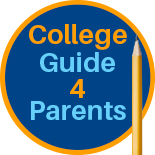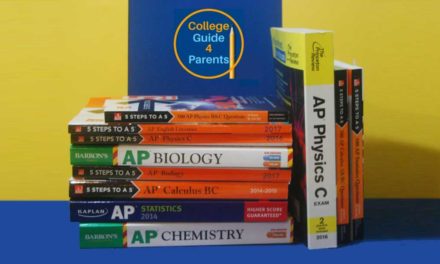This issue of College Guide 4 Parents’ College Application News focuses on how to get a National Merit Scholarship, factors to consider when choosing which college to attend, and why it is important to take challenging classes in high school.
In this newsletter, we focus on:
- how to find out if your junior will be a National Merit semifinalist
- how your child can become a National Merit finalist and obtain a National Merit Scholarship
- helping your child choose which college to attend
- why challenging coursework is important in high school
1. PSAT, what’s next?
The PSAT and National Merit semifinalists
If your child is in 10th or 11th grade, he/she may have taken thePSAT/NMSQT (Preliminary SAT/National Merit Scholarship Qualifying Test) on October 10, 2018. It is a good practice to prepare for the SAT, but most importantly, for 11th graders, it is the gateway to becoming a National Merit Scholar. It is a very coveted title because companies and colleges earmark money specifically for these students.
If your 11th grader took the PSAT this year, his/her score became available on collegeboard.comin December.
If you senior was notified in September that he/she was a semifinalist, he/she is currently waiting to see if he/she will be selected as finalist and hopefully get a scholarship.
Becoming a National Merit Scholar is an 18-month process. About 1.6 million juniors take the PSAT each October. In December, their scores are posted on collegeboard.com. Students then have to wait until September of the following year to learn whether they made it as semifinalists. Those who do can then apply to become National Merit Scholars.
Who becomes a semifinalist?
Being selected as a semifinalist is a big deal. For this reason, the students’ names are usually announced in local newspapers. So, how does a student become one?
First, the student must be:
- enrolled in a high school and be on track to graduate the year after taking the PSAT
- planning to attend a college full-time the fall following high school graduation
- a U.S. citizen or a U.S. permanent resident planning to become a U.S. citizen
- and take the PSAT during the third year of high school or earlier
Second, the student must score in the top 1% nationally as well as in his/her state
Of the 1.6 million who apply, the NMSC (National Merit Scholar Corporation) selects 50,000 high scorers. Thetop 16,000 become National Merit semifinalistswhile the remaining 34,000 juniors are given the title of “commended”,a distinction they should include in their college applications.
Students have to wait nine months between the time the scores are posted and the release of the list of semifinalists. It is impossible to know who will be selected ahead of time. However, understanding the process the NMSC follows to select those students will help you approximate your child’s chances to be selected.
How the NMSC chooses semifinalists
The PSAT highest score in 1520. However, the metrics NMSC uses to decide who will become a semifinalist is the NMSC selection index. This number is computed by adding your child’s scores in Math, Reading, and Writing and multiplying the sum by 2. The resulting number ranges between 48 and 228. Once logged into his/her collegeboard.comaccount, your child can find that number by clicking on “View Details” on the “Student Score Reports” screen.
Whether your child will become a semifinalistdepends on his/her selection index and the qualifying selection index of the state he/she lives in.This is how the NMSC identifies those who score in the top 1% within their state as well as nationally.
The qualifying selection index varies from state to state. For instance, for current seniors living in California, the qualifying selection index is 223. Therefore, those who got a selection index of 223 or above became semifinalists. In North Dakota, on the other hand, the qualifying index is 212. In this case, students with a selection index as low as 212 received the title of semifinalist.
Will my junior be a semifinalist?
The NMSC does not publish the list of state qualifying selection indexes, but several college prep experts were able to gather that information. PrepScholar publishedthe list of the most recent state qualifying selection indexes. These are the numbers the NMSC used to evaluate those who took the PSAT in 2017.
The indexes the NMSC will use to assess your 11th grader will likely be different. It is, however, possible to predict a state’s qualifying selection index. PrepScholar advises adding 2 to 5 points to your state’s current qualifying selection index to get an estimate of what next year’s number will be. Therefore, using this list and the selection index obtained by your child, you should be able to gauge the likelihood that he/she will become a semifinalist.
Related online resources:
National Merit Scholarship Program by the National Merit Scholarship Corporation
Description of the National Merit Scholarship Program, what is a commended student, semifinalist, and, finalist and what are the types of scholarships awarded
Steps a National Merit semifinalist must take to become a finalist.
Official Fall 2018 student guide for the National Merit Scholarship Program
The PSAT/NMSQT official student guide explains the rules of the National Merit Scholarship Program.
Does your PSAT score qualify for National Merit? by PrepScholar
PrepScholar provides the list of the most recent state qualifying selection indexes.
How to become a National Merit Semifinalist by PrepScholar
A good explanation of what students need to do to become a National Merit semifinalist.2. National Merit Finalists and National Merit Scholarships
National Merit semifinalists are notified in September of their senior year. Next they get the opportunity to become National Merit Finalists and National Merit Scholars.
How to become a finalist
After receiving notification that they were selected as semifinalists, students have about a month to submit their applicationto the National Merit Scholarship Corporation (NMSC). It will consist of:
- a transcript
- SAT scores of 1400 or above – ACT will also be accepted starting in 2019
- a description of extracurricular activities and community service
- recommendation letters
- a personal essay (500-600 words)
- the online application form
Finalists are announced in February. The NMSC selects about 15,000 students from the 16,000 semifinalists.
How to become a National Merit Scholar
National Merit Scholars are finalists that receive a scholarship through the NMSC. Typically, about half the finalists become scholars.
There are three types of scholarships to which students apply as part of their application:
National Merit Scholarship awarded by the NMSC
- It is a one-time award worth $2,500.
- All finalists are eligible
- Only 2,500 finalists receive it
Corporate-sponsored scholarships
Several companies award scholarships to finalists. Here is the list of the participating corporate-sponsors (see pp. 10-20).
In most cases, only children of these companies’ employees are eligible for these awards.
College-sponsored scholarships
Most of the scholarships awarded come from colleges. To qualify, students should consult the list of participating schools (see pp. 21-23) to see if it includes at least one of the colleges to which they applied. If some are included, they should then include in the NMSC application the one they are most likely to attend. This selection is, however, not set in stone since your child will be able to update that information until May.
In March, participating colleges receive the list of finalists and use this information to offer scholarships to them. Universities start sending out notifications of these awards in May.
Related online resources:
Official Fall 2018 student guide for the National Merit Scholarship Program
The PSAT/NMSQT official student guide explains the rules of the National Merit Scholarship Program.
National Merit Finalist – How to win the scholarship by PrepScholar
This post explains the steps involved in becoming a National Merit finalist and winning a scholarship.
How to win a National Merit Scholarship by PrepScholar
A post about becoming a National Merit Scholar
Link to the website of the NMSC online application.
List of colleges that award National Merit Scholarships
List of companies that award National Merit Scholarships
3. COLLEGE APP – WHAT TO DO THIS MONTH
Seniors are starting to receive their college decision notifications
Soon your child will havereceived all the college decision notifications he/she is expecting, and it will be time for him/her to select the school he/she will attend.
College Parent Central reminds parents that the student “will need to feel good about this decision, live with this decision, and make the college experience work. It is your job to be a helpful passenger on this journey, but not a back-seat driver.”
It recommends that parents be patient, supportive, and act as sounding boards rather than drive the decision process.
Parents can, however, make sure their children take into account the following factors:
Finances
Each college should have sent to your child a financial aid award letter indicating how much financial aid and merit-based scholarships he/she is eligible for and how much of the cost your family will be responsible for.
Cost should not be the only parameter to consider while selecting a college. However, it is essential to assess which schools your family can afford, how much loans your child can realistically take on, and how much of a burden these will place on him/her in the years following graduation.
If the school your child has his/her heart set on is too expensive, CollegeXpress advises contacting the school to express his/her interest and ask for more aid. It also suggests meeting with the school’s guidance counselor to see if he/she can recommend additional scholarships to apply to.
In case your child’s top choice is out of your budget, College Parent Central advises parents to remind their seniors that no college will be a perfect match.
Academics
The college your child select should offer a wide array of majors. This will ensure that, in case your child decides to change or add a major, he/she will have options. Others things to consider are the quality of the faculty, campus facilities, and research opportunities.
Community and location
The college environment, as well as its surroundings, should also be taken into account.
Does your child prefer to be part of a large campus with thousands of students or a small liberal arts college with only a few hundred people? Would he/she feel more at home in a college where most students stay on campus, one where students move off campus in sophomore year, or one that caters solely to commuters?
The surrounding area matters too. Does your child prefer a university town or a large city with access to theaters, shows, and museums? Is it a safe and pleasant area with recreational opportunities? How is the quality of life? Is the cost of living affordable?
Many colleges host events for accepted students. Seniors are invited to stay overnight, attend a few classes, and get a feel for the campus. If your child hesitates between several schools, attending such events may help him/her decide at which college he/she would feel most at home.
Related online resources:
The college decision dilemma by College Parent Central
College Parent Central offers advice to parents about supporting their student through the process of selecting which college he/she will attend.
How to choose a college once you are accepted by CollegeXpress
Advice for students who are in the process of deciding which college to attend.
Top factors to consider when choosing a college by CollegeXpress
7 factors to take into account when choosing a college.
IMPORTANT DATES
| TEST NAME | TEST DATE | REGISTRATION DEADLINE | LATE REGISTRATION DEADLINE | OFFICIAL WEBSITE |
| ACT | April 13, 2019 | March 8, 2019 | March 9-25, 2019 | act.org |
| ACT | June 8, 2019 | May 3, 2019 | May 4-20,2019 | act.org |
| SAT | March 9, 2018 | February 8, 2019 | February 27, 2019 | collegeboard.org |
| AP Exams | May 6-17, 2019 | collegeboard.org |
4. FEATURE OF THE MONTH: Why taking challenging courses is important
Most high schools offer advanced classes in addition to their regular ones. These are considered challenging because the material taught is more complex, the amount of information covered is denser, and there is more homework than for regular classes.
A student will meet his/her high school’s graduation requirements whether he/she takes only regular classes or mostly advanced courses. For this reason, your child may be tempted to stick to easier classes and get an easy 4.0 GPA. The problem with this strategy is that admissions officers will look at the difficulty of the courses your child has taken to see whether he/she challenged himself/herself while in high school. Doing so allows them to assess a student’s readiness for college.
Adjusting to college courses is hard for most students because their content is advanced, homework is long and difficult, and often the only way to get any help with an assignment is to meet the professor during office hours. Taking a few advanced courses while in high school makes for a smoother transition to college.
Types of advanced courses
There are three types of advanced classes: AP, IB, and honors. While most high schools do not offer all three, your child will have the option to take some advanced courses.
AP (Advanced Placement) Classes
AP classes are growing in popularity and are available at most high schools. Some can also be taken online. College Board manages the Advanced Placement program and currently offers 38 classes in the sciences and humanities (course list).
The AP program allows students to take college-level classes at their school. The curriculum for each course is defined by a committee of high school teachers and college professors hired by College Board. This ensures that the material covered in an AP class covers the same content as the corresponding college course. For instance, “AP Physics C” replaces “University Physics 1”.
Taking an AP class will count towards your child’s high school graduation requirements. Moreover, by doing well on his/her AP tests, he/she can also gain college credits.
To complete all of the AP requirements, students also take an AP test for each class they attended that year. These exams are not given within the context of the AP class. They are standardized tests, like the ACT, administered at your child’ school by College Board. In most case, students who do well on these tests will be granted college credits when they start their bachelors. For some classes, the student will get credit for a single college class. For instance, AP Psychology will replace a college’s introductory class in psychology. Getting a 4 or 5 on the AP Calculus BC test, however, will allow a student to skip taking the Calculus I and II college courses.
Pros:
- students can gain college credits
- students get used to the rigor of college courses
- AP classes are open to all students
Cons:
The course must cover all the curriculum established by College Board. If the teacher is uninspired by the content, the class may not be very exciting. Inquire about who teaches the course and about how well last year’s students performed on the AP test.
IB (International Baccalaureate) programs
Just like AP classes, IB courses allow a student to earn college credits. To offer IB classes, a high school must set up an IB program, which can be costly. For this reason, only a few hundred U.S. schools offer it.
Pros:
- students can earn college credit
- prepare for the rigor of college coursework
Cons:
- It may be difficult to find a school offering the IB program
- Only advanced IB courses qualify for college credits
Honors classes
Many high schools offer honors classes. These are available only to good students who want to challenge themselves. Their curriculum is defined by the school or the state and, therefore are not part of a program standardized across the U.S. As a result, in most cases, students will not be able to get college credits for taking them.
Pros:
- prepare students for the rigor of college courses
- if the teacher has input in deciding what the class will cover, he/she may be more passionate about teaching it.
Cons:
- In most cases, these classes do not qualify for college credits except for some in-state schools.
- Honors classes are competitive; therefore not everyone is allowed take them
Should my child take advanced classes?
If your child is struggling in his classes, taking advanced courses may not help. It is, however, important to reassess your child’s options every year. First, not all advanced classes are equally difficult, which means that some easier ones may be a good option for him/her. Second, as a child progresses through high school, he/she matures and is exposed to increasingly more advanced material. As a result, by the time he/she gets in 12th grade, advanced classes may be a breeze for him/her.
Your school advisor will be able to guide your child and you on the selection of his/her courses. Be sure to meet with him/her yearly before selecting next year’s class schedule.
Related online resources:
College 101: AP vs. Honors vs. IB by Shmoop
A comparison of AP, IB classes, and honors classes.
What is better for you: IB or AP? by PrepScholar
A comparison of AP and IB classes.
Use AP Credits to graduate from college in 3 years by U.S. News
How using AP classes to earn college credits can allow a student to graduate from college in 3 years.
These are the 5 worst problems with College Board’s AP program by PrepScholar
Some of the drawbacks of the AP program.
Study Up: scoring AP credit for college isn’t easy by CNBC
How to earn college credits with AP courses.
5. PREVIOUS COLLEGE GUIDE 4 PARENTS’ COLLEGE APP NEWS AND RELATED POSTS
Topics : What is a good ACT score, obtaining good letters of recommendation, documenting your child’s extracurricular activities
Topics : What is a good ACT score, obtaining good letters of recommendation, documenting your child’s extracurricular activities
October 2018 College App News – ACT Superstore, Sending Scores, College Essays
Topics : ACT scores vs. superscores, test-flexible schools, how to send scores, and how starting extracurricular activities as early as 9th grade will help when writing college essays
September 2018 College App News – PSAT, ACT, Early Action, Early Decision
Topics: 2018 PSAT test, taking the ACT in the fall, and volunteering before senior year
2018-19 College Essay Advice: 82 Posts by College Prep Experts
This article contains links to 82 posts about writing this year’s college essays, like the Common Application, Coalition Application and ApplyTexas essay prompts, and the application and supplemental essays for 62 popular colleges including several ivy league schools, the universities of New York and California, and Texas A&M.
6. REQUEST FOR COMMENTS
If this information were of help to you or if there are topics you would like me to address, please leave a comment.





